The Champions League returned for the third matchday of the group stage. For several teams who have secured two wins out of two matches, this will be the chance to move closer to a spot in the Round of 16. Meanwhile, a positive result could be a platform for something bigger for the minor teams.
Manchester City were one of the few teams who were still unbeaten from the start of the campaign with two wins over Dinamo Zagreb and Lokomotiv Moscow. In a group where the English side have the highest possibility of making it into the knockout rounds, it’s no doubt that they have and will deliver. Meanwhile, Atalanta were expected to be one of the surprises in the Champions League this season. But they have been underperformed as Gian Piero Gasperini’s side were still looking for their first point of the campaign.
And before their trip to the Etihad Stadium, many have predicted this clash to be the toughest for Atalanta. Indeed, only a few minutes after Ruslan Malinovskiy’s opening goal, Man City started to push forward. A brace from Sergio Agüero inside the first half was followed up by Raheem Sterling’s hat-trick in just eleven minutes of the second period to complete a dominant win for the home side.
This tactical analysis will provide an analysis of Man City’s 5-1 win at home against Atalanta. Meanwhile, using statistics, we will point out the interesting tactical points in Pep Guardiola’s tactics and what positives can Gasperini and his players take home from his tactics.
Lineups
With most of his squad returned from different injuries, Pep Guardiola had a near full squad to select from. He opted for a 4-2-3-1 formation. Aymeric Laporte and Leroy Sané still remained sidelined as they are still recovering from knee injuries. On the other hand, he welcomed two key centre-backs in Nicolás Otamendi and John Stones back into the team and they both made an appearance on the bench.
The Spanish manager started two central midfielders in Rodri Hernández and Fernandinho as the two centre-backs in this match, which was a very interesting point to note. Kyle Walker also trained with the whole squad in recent weeks and he went straight into the right-back position.
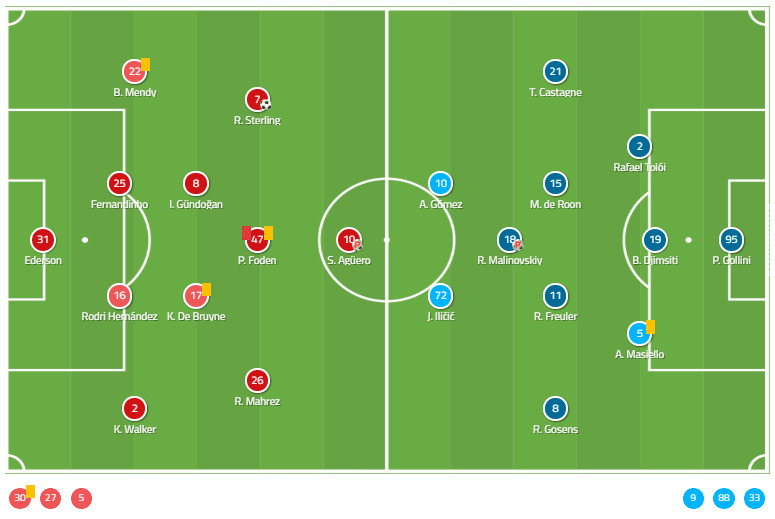
Meanwhile, Gasperini went for his usual 3-4-1-2 formation along with the fact that he also had a near full squad to pick from. With Duván Zapata absent from this match, the Italian manager went for Atalanta’s captain Alejandro “Papu” Goméz and Josip Iličić to lead the line, while Luis Muriel made an appearance on the bench.
Playing behind them was new signing Ruslan Malinovskiy while the duo of Timothy Castagne and Robin Gosens occupied both wings. On the bench, they also had another wing-back duo in Hans Hateboer and another new addition this summer in Guilherme Arana.
Manchester City’s style of play
As mentioned, the fact that Guardiola played Rodri and Fernandinho at the heart of Man City’s defence was very interesting. Fernandinho is mainly deployed as the destroyer in front of the defensive line in most matches. Meanwhile, Rodri is more of a playmaker who tends to dictate the play and make penetrative passes to create chances for his teammates.
To see those two paired up as centre-backs instead of Stones and Otamendi, Guardiola clearly had something in mind. And indeed, it showed clearly when Man City played out from the back. Their ability to carry the ball forward and passing ability was two of the attributes that he wanted them to demonstrate. Against an Atalanta side who pressed high up the pitch, composure and concentration became important to circulate the ball among the defence and then progressed it forward.
At times, Rodri also moved slightly up the pitch and created a double pivot in the middle of the pitch alongside Ilkay Gündogän. This allowed Kevin de Bruyne to join the attacking midfielders while also switching the team’s formation into a 3-2-4-1. The pivots moved flexibly in between the defenders and the attacking midfielders, acting as the link between them. They would offer to pick up the ball, dictate the play and make decisive passes that could create dangerous chances.
Furthermore, Guardiola’s inverted wing-backs still played a very important role in his tactics. As shown below, Benjamin Mendy wasn’t hesitated to tuck inside and became the third centre-back involved in the build-up. At the same time, Kyle Walker moved wider to occupy the right-hand side. The same thing happened when the build-up took place on the opposite side, when Mendy stayed wide and Walker moved slightly into the half-space.
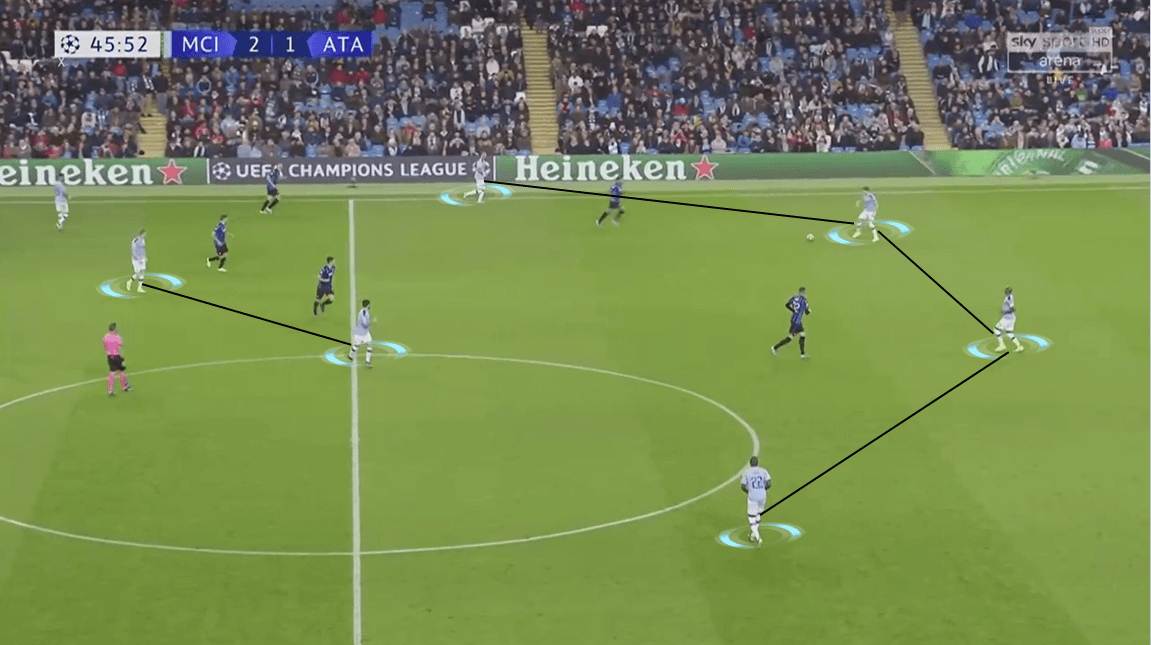
But the role of an inverted wing-back doesn’t stop in the build-up. They also played a key part in how Man City attacked, using movements inside the half-spaces. Earlier in the situation that led to Agüero’s equalising goal, Walker made a progressive run into the right half-space after being involved in the build-up. Right from the start of his run, the former Tottenham defender had already dragged along centre-back Andrea Masiello.
Firstly, his movement allowed Riyad Mahrez to move wide and stretched Atalanta’s defensive shape. Secondly, when he entered the final third, Masiello stuck with him and that created a big gap behind his back. Mahrez made the most out of it by cutting inside rather than making a pass into Walker’s run. He knew that Robin Gosens would be on his weaker side to chase after him and wouldn’t be able to tackle the ball. A string of passes came later which saw Mendy send a cross into the box for Agüero and his close-range shot didn’t face any pressure.
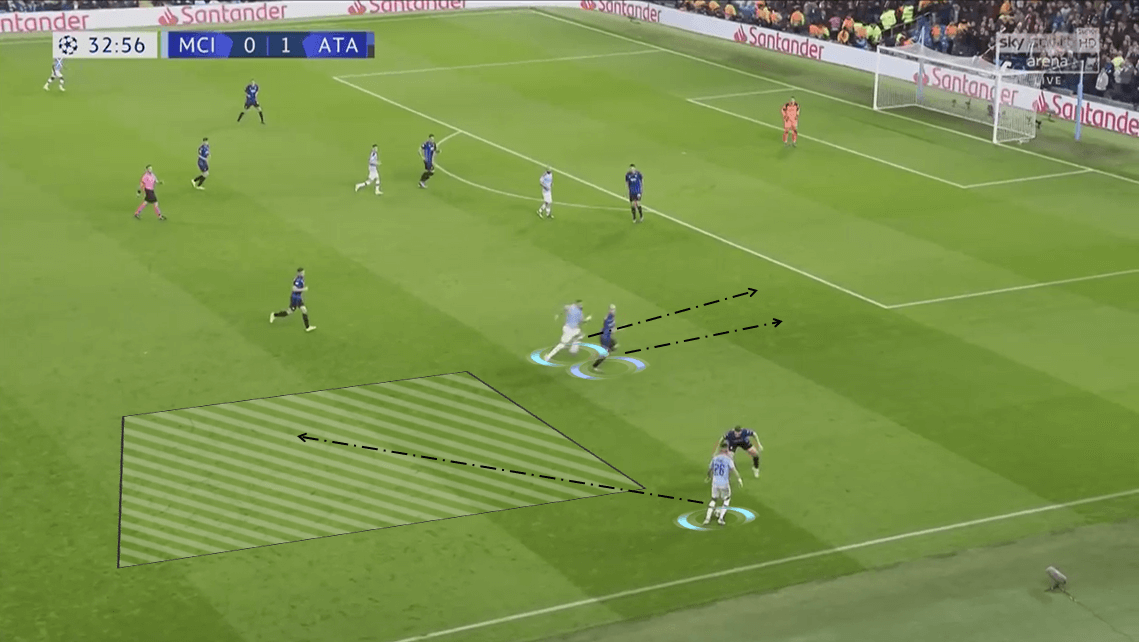
Another attacking method that Man City also used was capitalising spaces. During their build-up and transitioning process, Atalanta tended to push their formation higher up the pitch. The aim was to suffocate the home side inside their own half and allowed the players to recover possession more effectively.
But playing against a team who is good at bypassing pressure, Atalanta saw their strategy being countered heavily. The likes of Phil Foden, Fernandinho or De Bruyne didn’t face much trouble in progressing the ball out of their defensive third. It was easy for them to reach the middle third and look for potential receivers. Also, by committing too many players into the opposite half, the visitors found themselves lacking players to defend against the attack.
This, of course, created gaps in between the defenders and behind them. Using intelligent movement and positioning, Man City’s attackers easily turned up at the end of through passes. With the intention of coming back into the match, Atalanta pushed up on more occasions in the second half. So it’s no surprise to see the home side made the most of this method to approach the 16-yard box.
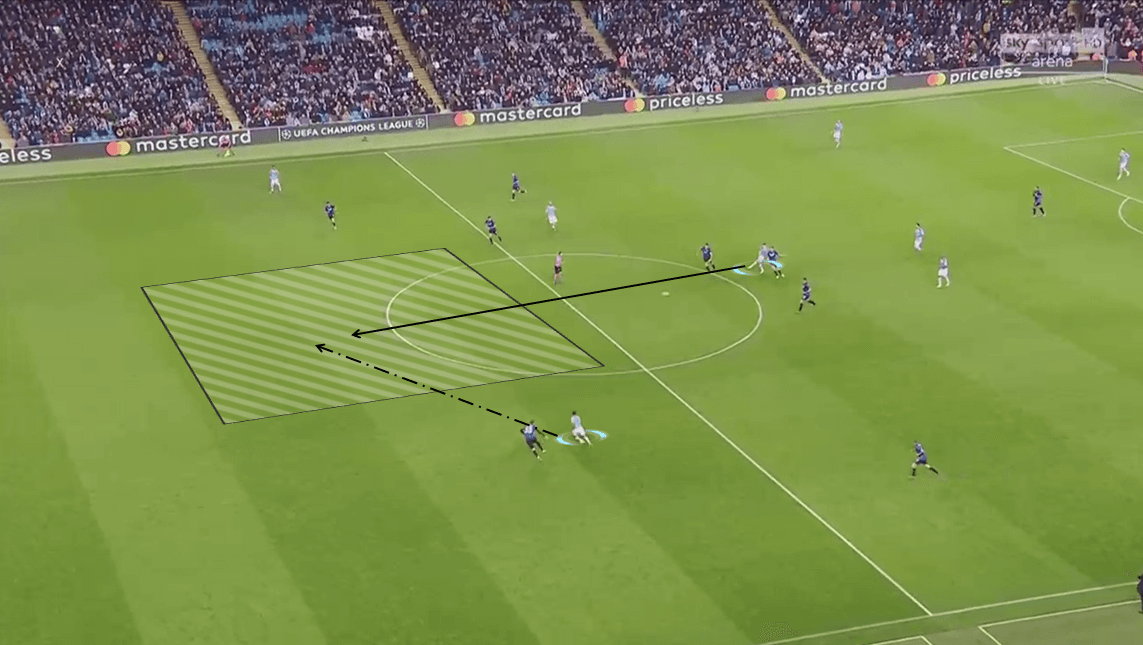
Being a wing-oriented team during the majority of the match meant that Man City also tended to distribute the ball wide. We have analysed the importance of inverted wing-backs in the team’s tactics during both build-up and attacking situations. Their flexible movements combined with the ability of both Sterling and Mahrez had created a dangerous threat from the wings.
On several occasions, the home side even attempted to use crosses into the box. This allowed the players inside that area to continue their run while beating their markers for a close-range shot. It happened in a similar way when Sterling completed his hat-trick and rounded up the game for Man City, with Mahrez found the England international with an exquisite cross.
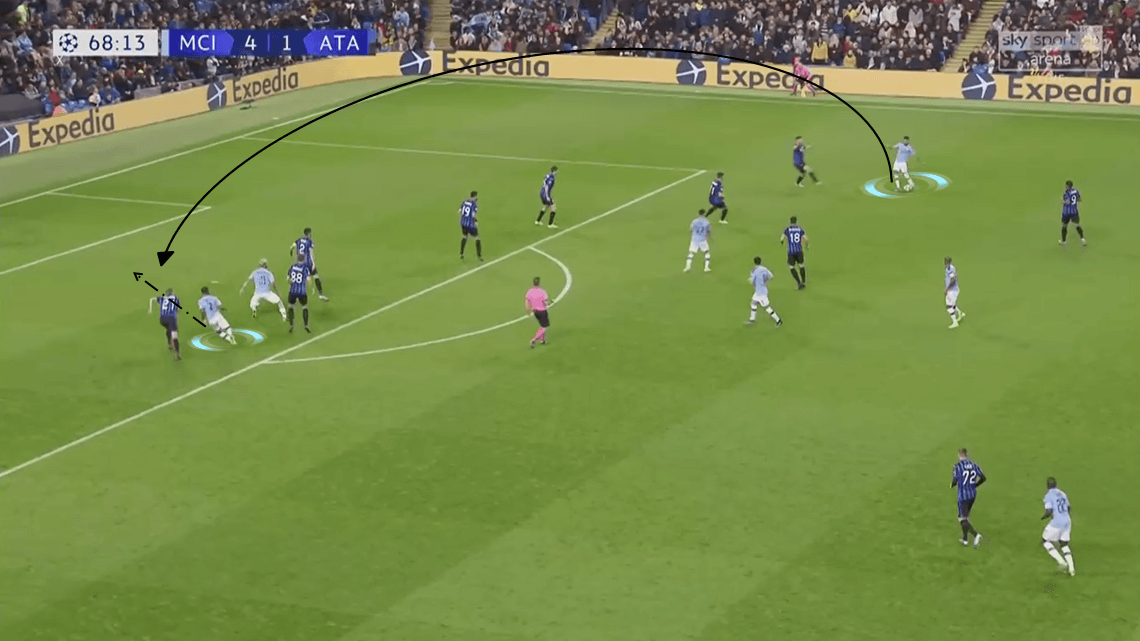
Defensively, Man City formed a 4-5-1 defensive shape to counter against Atalanta’s attacking threat. Still, it is possible to notice on several occasions of the match that Foden usually moved away from his position. He moved slightly forward and switched the team’s defensive formation into a 4-4-2 by positioning himself alongside Agüero.
By doing so, he prevented the scenario of the Argentinian striker would have to press the centre-backs alone and lose the numerical superiority. With two players and the support from two wingers, it was viable to create an overload inside a certain area to win the ball back for a counter-attack. Although Man City didn’t go for such an aggressive mentality when they attempted to recover possession, Atalanta still struggled due to the fact that the players were placed upon an intense pressure from their opponent. Therefore, the possibility of a misplaced pass or a heavy touch became higher and the opposition’s attackers could capitalise on that to initiate a quick attack.
Atalanta’s style of play
It is never easy to play against a team that is managed by Guardiola, as the Spanish manager always shows a bit of flexibility in his tactics. Depending on the opponent that his team is facing, he will adjust the formation and style of play to fit and able to counter against the opponent’s tactics. Atalanta were never an exception, and as he mentioned in his pre-match conference, research was done and they had full confidence in breaking their tactics down.
In contrast, though, Atalanta did enjoy a fairly successful first-half, capitalising spaces to create chances. Using a five-man midfield and two intelligent strikers, the visitors usually found gaps in between Man City’s defenders. It allowed them to attack the box more easily by through passes into their runs.
The image below was the perfect example for several of these situations inside the first period. Although Man City remained discipline in their defence, Remo Freuler still managed to send the ball towards Iličić. Unfortunately, his first-touch was pretty heavy and allowed Fernandinho to recover possession.
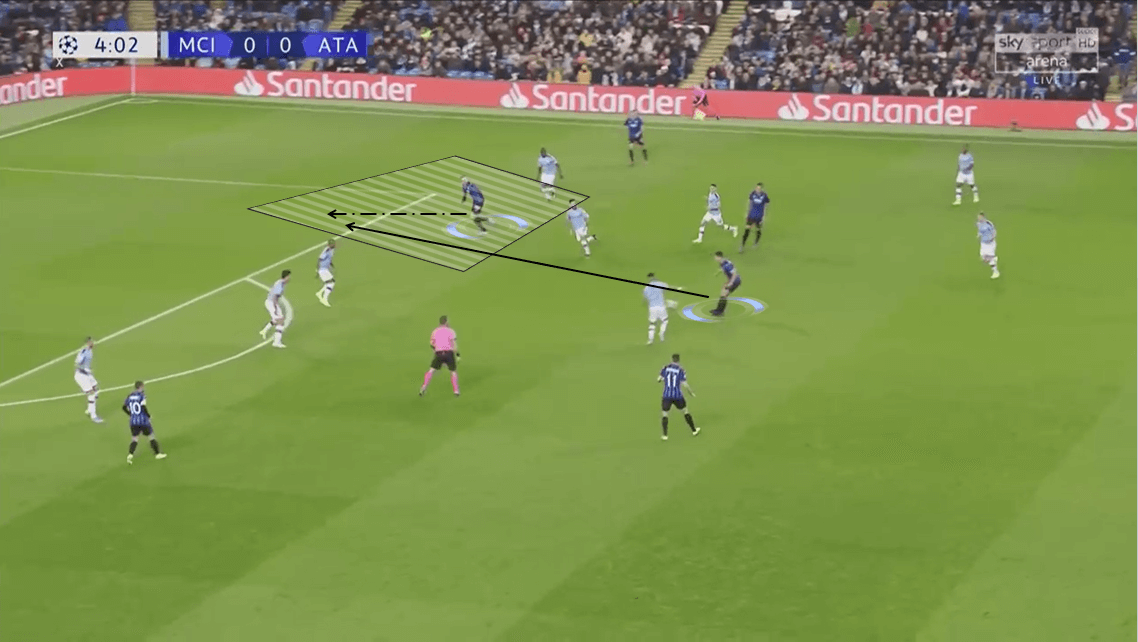
The mentioned situation was not the first time the away side made the most out of this method. Similar to Man City, they were a wing-oriented team and tended to attack down both flanks. In Castagne and Gosens, Atalanta have two dynamic wing-backs who can fulfil this attacking and defending responsibility.
In this match, though, they preferred to distribute the ball into Gosens’ left-hand side. As the image below demonstrated, the former Groningen defender attempted to attack the space behind Man City’s defensive line. The home side’s defensive line is usually pushed up preferring to defend zone 14. However, this left the space in behind unoccupied.
It is worth noticing that Atalanta were able to do this due to the fact that the strikers and the attacking midfielder positioned themselves in between Man City’s defensive lines. They created a confusing situation of who should mark who, which also pinned the line down. Another point that could also be seen is Rodri tended to push higher than the other defenders. Not only during the build-up situations, but he also did a similar thing on several of Man City’s defending scenarios.
Again, the image below was not an exception, either. Notice how Iličić’s positioning dragged the former Atlético Madrid midfielder out of his position. If Gómez quickly moved into that space behind Rodri, he could be a viable passing option for Malinovskiy and create a dangerous chance.
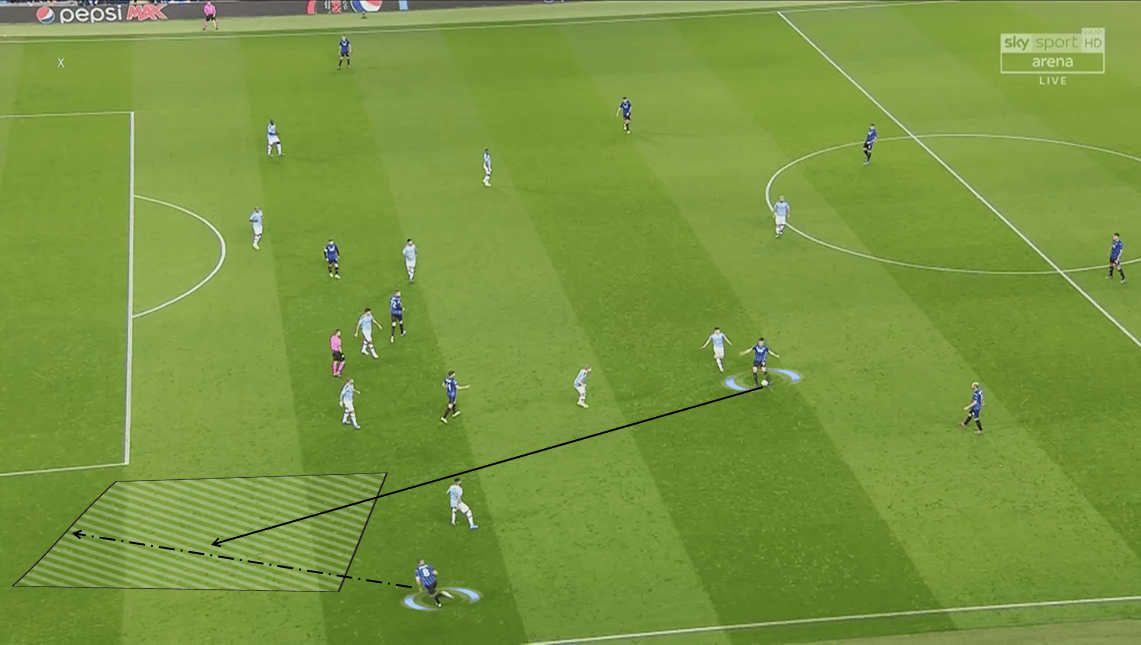
During their build-up process, they also made the most out of their 3-5-2 formation. The three centre-backs tended to position themselves on the edge of the middle third. Meanwhile, Malinovskiy wasn’t hesitated to move back and join the other two central midfielders. They created a passing block inside the middle third to counteract Man City’s pressing.
This brought them a huge advantage in winning numerical superiority and also forced Man City to push their formation higher. While they were able to circulate the ball among the block, Atalanta’s centre-backs should have gone with the option of making long passes. Gómez and Iličić usually positioned themselves on the shoulders of defenders, which made them great passing options if they intended to attack the space behind Man City’s defensive line.
They also had two decent playmakers in their squad in Marten de Roon, who had a decent knowledge about the Manchester-based club thanks to his playing time at Middlesbrough and Freuler. The former registered 49 passes in the match, the fourth-highest player in this aspect, while the latter only had three passes fewer. With the factors that they had in the match, Atalanta should have been able to create more chances towards Ederson’s goal.
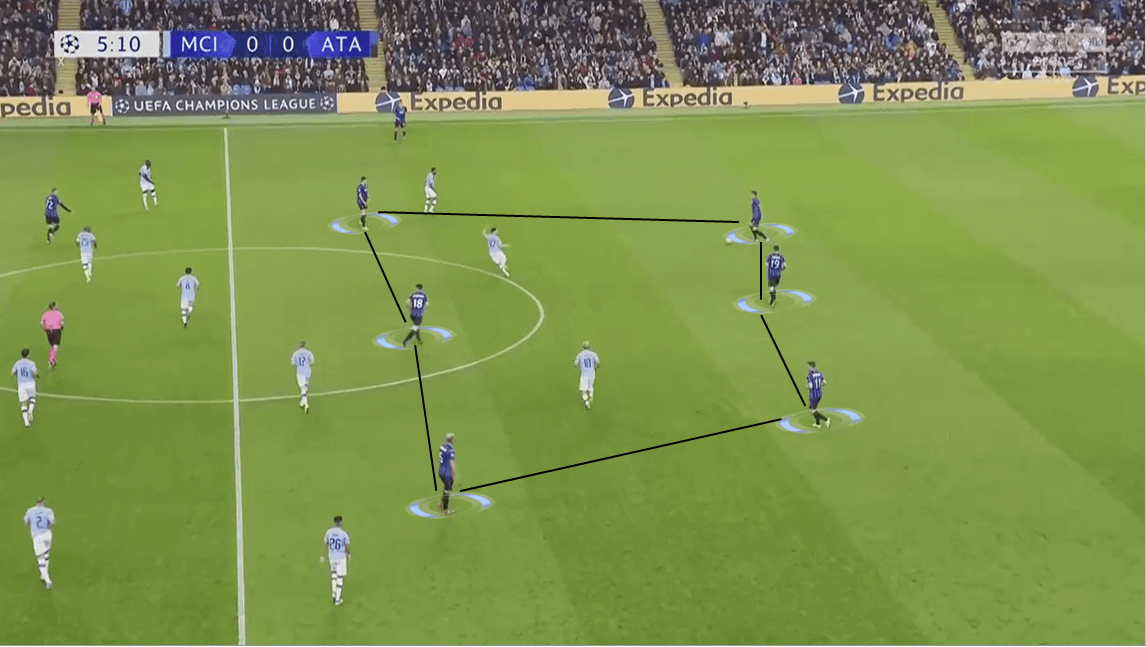
During their transitioning process, there were a noticeable tactical point that helped them circulate the ball much quicker. Whenever a player received the ball, there would be at least two players came near him to offer passing options. This third-man concept allowed Atalanta to create passing triangles wherever they progressed the ball to while decreasing the chance of Man City players tackled the ball away.
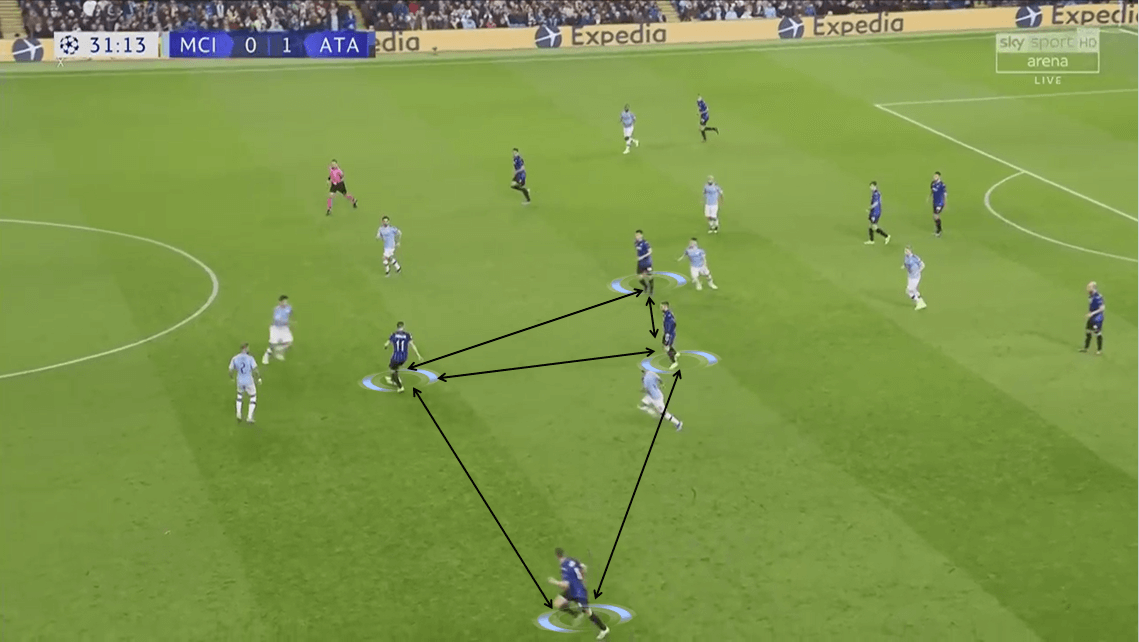
But Atalanta weren’t the only team who used the third-man concept during their transitioning process. Man City also put an emphasise on this strategy and it was the main reason that helped the English side to gain more time of controlling possession (55.3% compared to Atalanta’s 44.7%).
Generally speaking, this strategy allowed the ball carrier to create at least one passing triangle with two players surrounded him. There would be one player who positioned himself in free space and ready to receive the ball. In the image below, the players who took on that responsibility were Rodri and Walker. They stood in a position with no pressure when they picked up the pass. In case the two players inside the overloaded area wanted to circulate the ball out, they would be the destination of their upcoming pass.
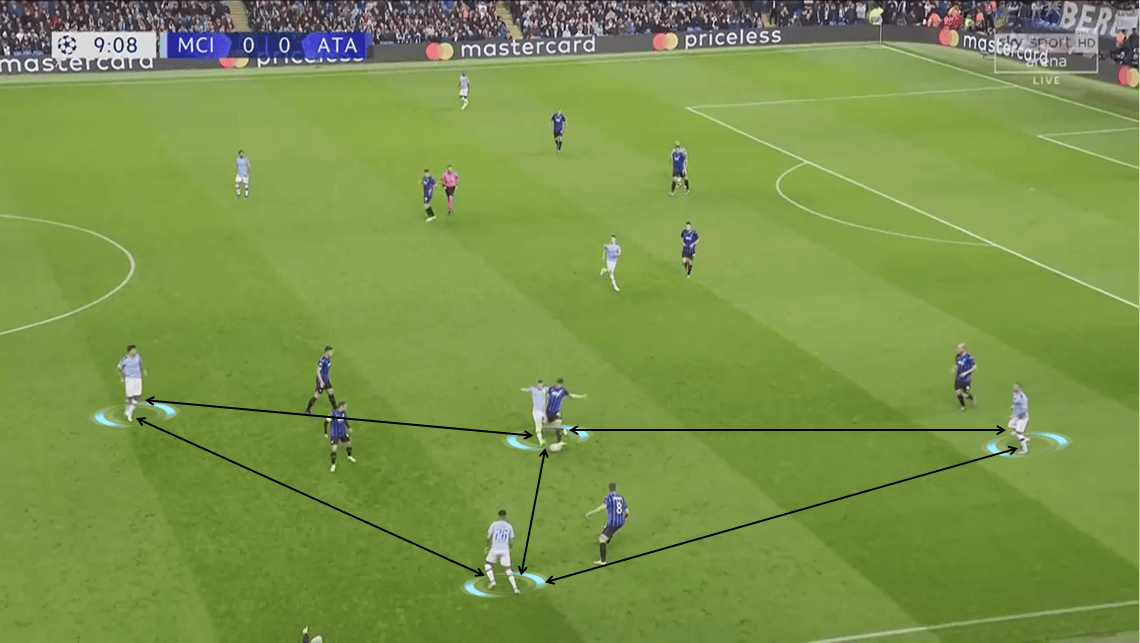
As expected, Atalanta approached a defensive situation with their familiar high-intensity pressing style of play. They also favoured man-oriented marking, as demonstrated below. Each of Atalanta player would follow an opposition’s defender, with the aim of suffocating Ederson’s passing options. This would prevent them to build from the back, which was Man City’s favourite style.
The pressing game was adapted by Atalanta on both ends of the field. Rafael Tolói and Masiello had a responsibility of marking Man City’s wingers. That left Djimsiti as a spare man, but Gasperini had other ideas for him. He would mark Agüero, who played as a dynamic striker and followed him as he dropped deep from his position. The Italian coach wanted his players to win the ball as soon as possible and prevented them from reaching Gollini’s goal. Man City used long balls to counter against this style of play on a fair few occasions. To deal with that strategy, the away side deployed a high defensive line while the strikers pressed the centre-backs.
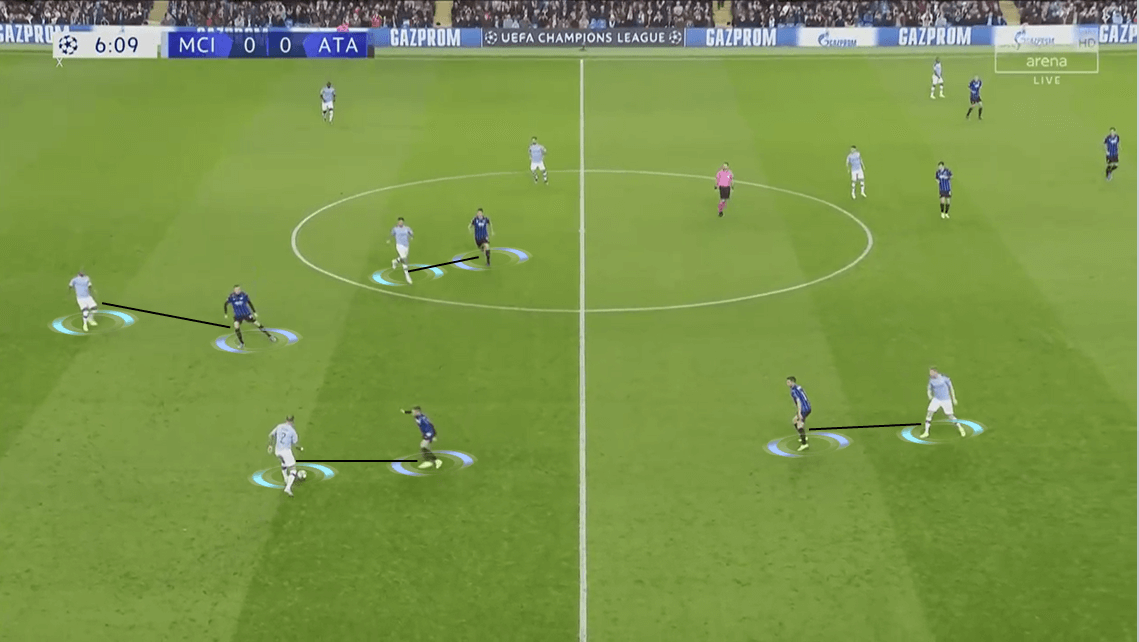
When Man City progressed the ball into their half, Atalanta would form a 5-3-2 defensive shape and focused on stretching the shape wider. Their aim was to occupy both the central and wide areas and closed down any possible gaps that Man City could capitalise on. As the home side were a team who tended to distribute the ball quite flexibly, it required them to be disciplined while limiting the space that the opposition’s players could make the most out of.
But as we analysed Man City’s style of play above, the players’ movements were crucial when they played against this defensive juggernaut. On several occasions, the likes of Agüero, Sterling, Mahrez or de Bruyne would roam from their positions and drag along several of Atalanta’s defenders. As a result, the visitors had had a tough day in limiting the home side’s attacking threat, which also made the fact that they conceded five goals was unsurprising. Furthermore, with ten out of fifteen shots on target, Guardiola’s side had a very efficient day in front of goal and broke Atalanta’s stubborn defensive structure down.
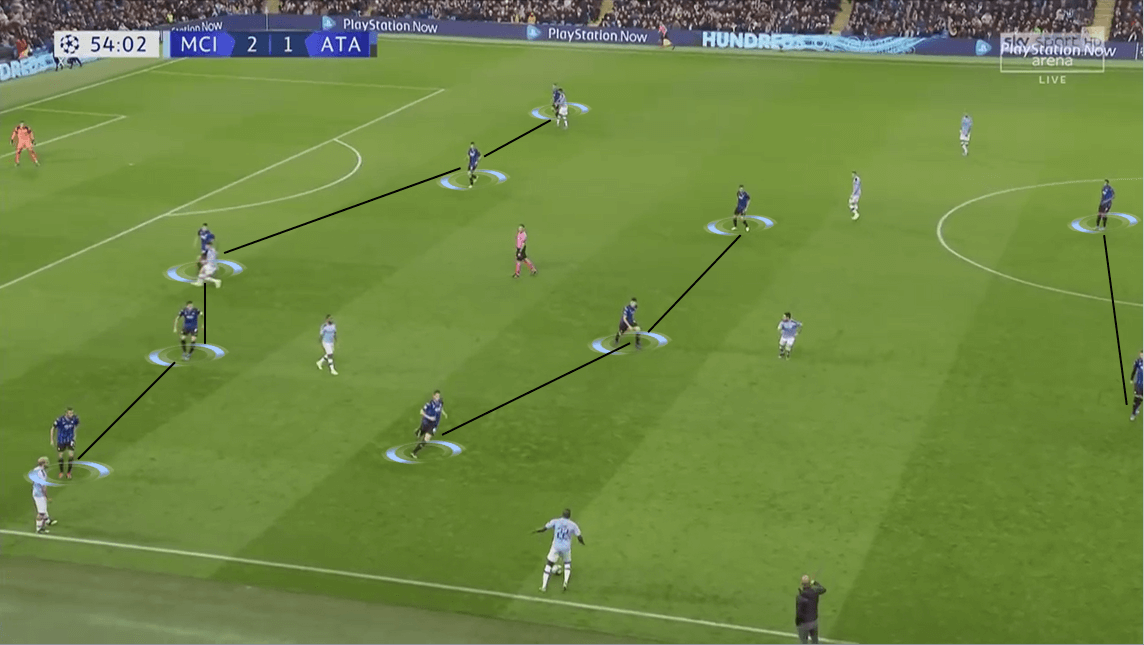
Conclusion
Before the match, many expected that this would be a very close match due to the fact that both Manchester City and Atalanta demonstrated two different attractive styles of play. Theoretically, the English side were no doubt the side that was rated higher than their opponent. Although Gasperini’s side managed to match Man City during the first few minutes and even created dangerous chances, things started to shift towards the home side, which showed in five goals that they scored.
With three wins out of three, Manchester City moves closer to becoming one of the first teams that qualify for the next round. The Premier League defending champion will hope to carry their form into their next three domestic matches, in which they face Southampton twice. For Atalanta, though, this match will be a valuable experience for them before they welcome Man City in two weeks time. But first, the Italian club will have three important clashes in Serie A with Udinese, Napoli and Cagliari respectively with the hope of maintaining their unbeaten form in the last five matches and their third place.

If you love tactical analysis, then you’ll love the digital magazines from totalfootballanalysis.com – a guaranteed 100+ pages of pure tactical analysis covering topics from the Premier League, Serie A, La Liga, Bundesliga and many, many more. Buy your copy of the October issue for just ₤4.99 here





Comments